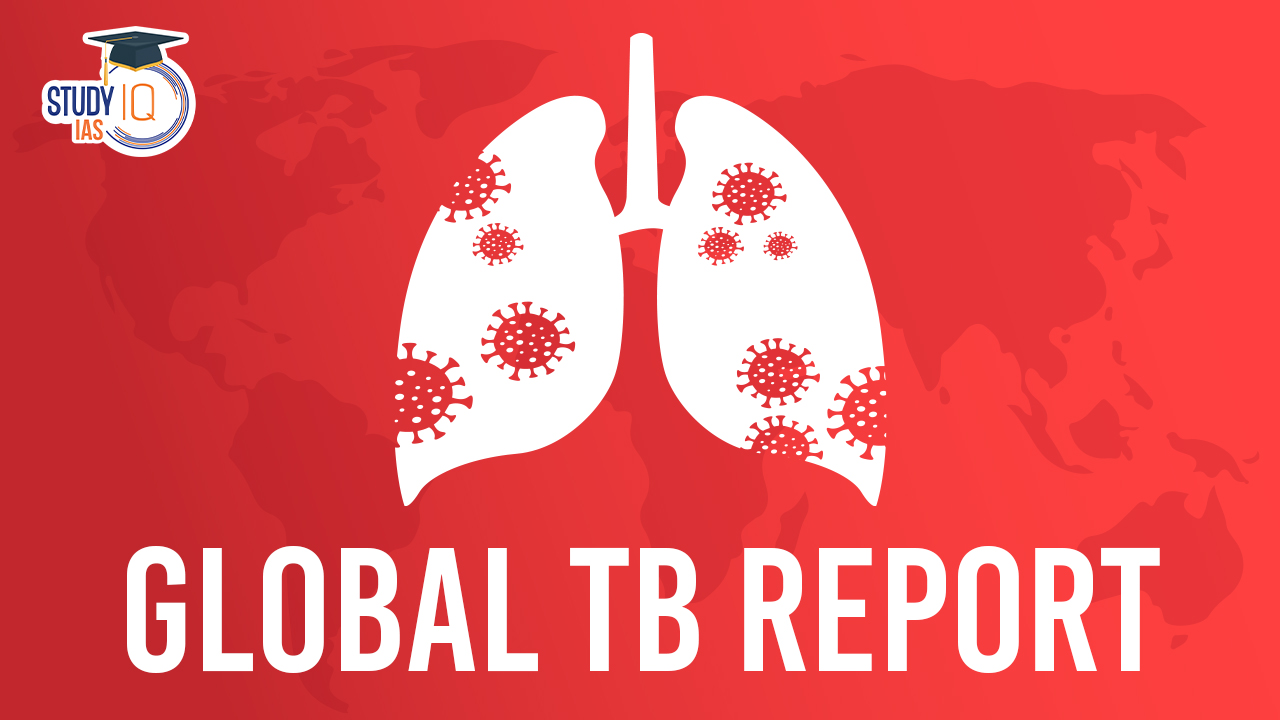Table of Contents
Context: Global TB Report 2023 has been released by the World Health Organization (WHO).
Global TB Report 2023 Key Findings
The Global TB Report is an annual report published by the World Health Organization (WHO) that provides a comprehensive overview of the global TB epidemic. The report includes data on TB burden, diagnosis, treatment, prevention, and research. The key findings of the Global TB Report 2023 include the following:
Global Overview
| Aspect | Detail |
| TB Cases in 2022 | There were 7.5 million tuberculosis cases, the most since the World Health Organization started tracking globally in 1995. |
| TB Incidence Rate | There was a 3.9% increase from 2020 to 2022, reversing the prior trend of decline. |
| TB-Related Deaths in 2022 | The death toll was 1.30 million, a decrease from the 1.4 million in 2020 and 2021, nearly aligning with the 2019 figures. |
| High TB Burden Countries |
|
India-Specific Data
- TB Cases in 2022: India reported 2.8 million TB cases with a 12% case fatality ratio.
- MDR-TB Cases: Approximately 110,000 cases were multidrug-resistant.
- TB-Related Deaths: There were 342,000 deaths due to TB, including 331,000 among HIV-negative individuals and 11,000 among those with HIV.
- India’s Global Contribution to TB Cases: In 2022, India had the highest number of TB cases globally, contributing to 27% of the world’s total.
What is Tuberculosis?
Tuberculosis (TB) is an infectious disease usually caused by Mycobacterium tuberculosis (MTB) bacteria. TB primarily affects the lungs (pulmonary TB) but can also affect other parts of the body (extrapulmonary TB). It’s one of the top 10 causes of death worldwide and a leading killer of people with HIV.
Key Aspects of Tuberculosis
Transmission of TB
TB spreads through the air when a person with active pulmonary TB coughs, sneezes, speaks, or sings, releasing tiny droplets containing the bacteria. However, it generally requires prolonged exposure to someone with active TB to become infected.
Types of TB
- Latent TB: The bacteria remain in the body in an inactive state and cause no symptoms. It’s not contagious but can become active.
- Active TB: The bacteria are active and cause symptoms, such as coughing, fever, night sweats, and weight loss. Active TB is contagious.
Risk Factors of TB
Including HIV/AIDS, diabetes, malnutrition, smoking, and living in or coming from a country with a high prevalence of TB.
Diagnosis of TB
- Skin Test: A small amount of a substance called PPD tuberculin is injected just below the skin of the inside of the forearm. The injection site is then checked after 48-72 hours.
- Blood Tests: Measure the immune system’s reaction to TB bacteria.
- Chest X-Ray: Checks for changes in the lungs consistent with TB.
- Sputum Tests: Examines sputum (mucus coughed up from the lungs) for the presence of TB bacteria.
Treatment For Active TB
- Standard Treatment for Active TB: Involves a combination of antibiotics over a period of at least 6 months.
- MDR-TB: This form of TB is resistant to the most effective drugs and requires longer treatment with second-line drugs.
Prevention From TB
- Vaccination: The BCG vaccine offers protection against TB.
- Public Health Measures: Include screening programs and ensuring those with active TB follow their treatment regimen to reduce transmission.
Global Efforts for TB
- The WHO and other international bodies are involved in the fight against TB, focusing on the prevention, diagnosis, treatment, and tracking of TB cases worldwide.
- The WHO’s End TB Strategy aims to reduce TB deaths by 95% and cut new cases by 90% between 2015 and 2035.
Initiatives Taken by Indian Government to Combat Tuberculosis
The Indian government has taken a number of initiatives to combat tuberculosis (TB), including the following:
- Revised National Tuberculosis Control Programme (RNTCP): The RNTCP is the flagship program of the Indian government for TB control. It was launched in 1997 and has since made significant progress in reducing TB burden in India. The RNTCP provides free diagnosis and treatment for TB patients, as well as preventive measures to prevent the spread of TB.
- National Strategic Plan to End TB (NSPETB): The NSPETB is a comprehensive plan to end TB in India by 2025. It was launched in 2017 and aims to achieve zero TB deaths, zero TB infections, and zero TB stigma. The NSPETB focuses on four key areas: early detection and treatment, preventive measures, universal access to quality care, and social support.
- Nikshay Poshan Yojana (NPY): The NPY is a nutritional support scheme for TB patients. It was launched in 2018 and provides financial assistance to TB patients to help them meet their nutritional needs during treatment.
- Direct Benefit Transfer (DBT): The Indian government uses DBT to transfer TB benefits directly to the bank accounts of beneficiaries. This has helped to reduce corruption and improve the efficiency of TB programs.
- TB Free Village Campaign: The TB Free Village Campaign is a community-led initiative to eliminate TB from villages in India. It was launched in 2018 and aims to reach all villages in India by 2025.
As a result of these initiatives, India has made significant progress in reducing TB burden in recent years. The number of new TB cases in India has declined by 24% since 2012. The government is committed to ending TB in India by 2025 and is working hard to achieve this goal.


 Agricultural Monitoring and Event Detect...
Agricultural Monitoring and Event Detect...
 Genetically Modified Crops in India, Reg...
Genetically Modified Crops in India, Reg...
 What are Polycyclic Aromatic Hydrocarbon...
What are Polycyclic Aromatic Hydrocarbon...





















